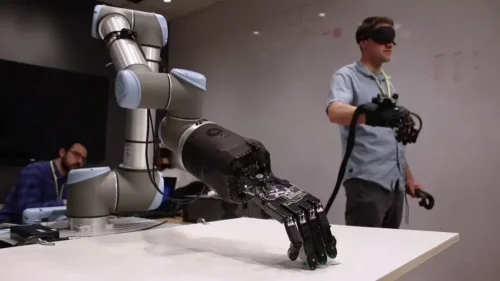Researchers have developed a telepathic device using a piezoelectric material and thin substrate that can replicate the sensation of touch.

What if we could feel in the virtual world as well? What if we could send robots to space and feel how it would feel to be on another planet? What if we could feel what the other guy feels afar? The concept of telepathy allows us to sense something similar. These sensations can be interpreted through tactile collection sensors and tactile reproduction actuators, the device allows people to feel textures virtually without touching objects in reality.
Researchers have developed a telepathic device that can be attached to the fingertip like a sticker and leverages the unique vibration pattern of touch and texture. By having this close contact with the skin, it is able to provide a more vivid tactile experience and bridge the immersion hindrance of other similar devices.
“Through the light and flexible on-skin tactile reproduction device that can be attached to the skin, we have taken a step forward in preparing a foundation environment for developing highly immersive virtual/augmented reality content,” said Hye Jin Kim, the lead researcher on the project.
Researchers used a piezoelectric element and an ultra-thin flexible substrate, which was able to precisely integrate microscopic sensors and actuators of less than 1mm on the substrate. The substrate is a thin bendable material with a thickness of 1/20 of a human hair (about 4㎛). The high-resolution composite sensor, which is finely structured at 1.8 mm intervals, can feel tactile patterns in a wide frequency range of 1 ~ 1,000 hertz (Hz).
The device when tested was able to simultaneously measure both slow-changing pressure (static pressure) and fast-changing pressure (dynamic pressure). The sensations can be transmitted in real-time, at a distance of up to 15m using Bluetooth communication. According to researchers, the delay time when transmitting the tactile/texture data signal was only 1.55 milliseconds (ms), and the acquired and reproduced signals matched approximately 97 per cent.
Researchers plan to innovatively advance the performance and form factor of the piezoelectric element to create complex tactile and texture levels that match reality by combining not only vibration but also various tactile stimuli.
Reference : Jin, H., Kim, Y., Youm, W. et al. Highly pixelated, untethered tactile interfaces for an ultra-flexible on-skin telehaptic system. npj Flex Electron 6, 82 (2022). https://doi.org/10.1038/s41528-022-00216-1






